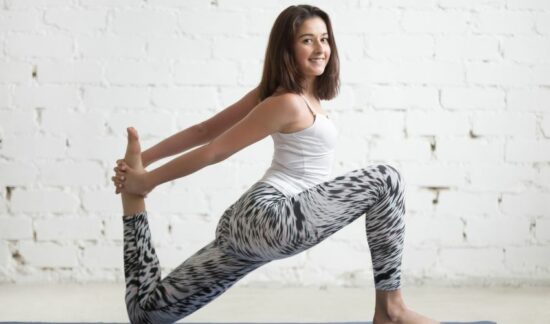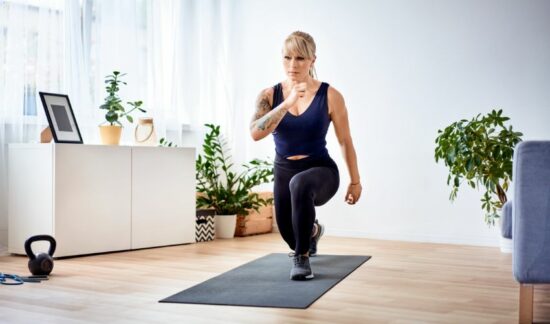Pain in the lower back and hips, as well as damage, can be brought on by tightness or weakness in the hip flexors. You may strengthen your hip flexors and reduce strain by doing the exercises shown here.
Although not everyone can have hips as flexible as Shakira’s, we can all benefit from exercising the muscles that support these ball-and-socket joints by stretching and building strength in those muscles.
Our hips are responsible for more than just the banging dance moves that we blast out every once in a while. Because they are necessary for both mobility and movement, they are an important joint not only for athletes but also for people who don’t participate in sports.
Hip flexors can become tight when we sit for long periods of time throughout the day, which is typical for most of us. In addition, leading a sedentary lifestyle is linked to a loss of strength in the hip muscles, including not just the hip flexors but also the muscles that work against them, such as the glutes, hamstrings, and abductors.
Pain in the lower back and hips, as well as damage, can be brought on by tightness or weakness in the hip flexors.
And that’s not the end of the hip problems. According to research conducted in the United States, hip replacement surgery and hip arthroscopy, which is a treatment used by physicians to diagnose joint problems, are both on the rise.

Who Are These Mysterious Hip Flexors?
A collection of muscles known as the hip flexors are responsible for flexing the hip, which means raising the leg higher and closer to the body. The psoas major and the iliacus are the two key muscles that flex the hips; when considered together, these two muscles are referred to as the iliopsoas.
The psoas muscle has its start in the six vertebrae that are located at the base of your spine. The origin of the iliacus can be found in the interior bowl of your pelvis. They come together and implant into the top of the femur, which is the uppermost bone in the leg.
Lifting, pushing, and tugging are all movements that challenge the iliopsoas muscle, and it responds by helping to support the trunk. Additionally, the iliopsoas brings the knees in closer to the chest. One illustration of this would be bringing your front leg around to the front of your body when jogging or when executing kicking motions in sports like soccer.
Here are eight fantastic hip flexor workouts and stretches that will help you stay strong and flexible, as well as maximize your hip mobility. This will help you prevent injuring your body when you’re busting a move, or even when you’re just strolling down the street.
Instructions For Stretching Out Your Hip Flexors.
You can loosen up your hip flexors and joints by trying out these stretches. They are designed to extend the possible range of motion that a joint is capable of moving through. After you’ve finished your workout and your body is already warm, it’s the perfect time to complete these stretches.
1. Hip Flexor Stretch In A Half Kneeling Position
This straightforward exercise targets the iliopsoas and hip flexors of the back leg while also targeting the glutes of the front leg. You can practice this exercise either on a yoga mat or by placing a towel that has been folded in half beneath your knee.
- Place your left foot flat on the floor in front of you while you kneel on the ground. Place your right knee on the ground behind you.
- Maintain a lofty trunk position while you work through this exercise. You can maintain your equilibrium by keeping your hands on your left knee.
- Slide your right knee backward in a gentle and controlled manner until you feel a slight stretch at the front of your hip.
- Put some pressure on your right buttock as if you were going to push forward, and pull your trunk and hips closer to your left foot. Create a pelvic tilt by tucking in your hips ever-so-slightly.
- Hold this position for ten to thirty seconds after taking a deep breath.
2. Bring The Knees Up To The Chest.
- Place yourself on your back with your legs stretched out in front of you. Bring one leg into the chest area as slowly as you can.
- While maintaining a flat back, bring your knee as close to your chest as you comfortably can while maintaining a flat back.
- Pull your glute in as tightly as you can while stretching out your straight leg as far as it can go.
- After that, come back to the beginning position and repeat the exercise with the other leg.
- If you are not experiencing any stretching sensations while completing this stretch, you might try doing it while seated on a bench with your lower leg hanging off.
3. Pigeon Pose.

The Pigeon pose is one of the most challenging yoga positions. Only proceed if you are confident in your ability to maintain the stance. You are welcome to change it up by performing a figure four stretch while seated in a chair or lying down on the floor.
- Get into the plank posture to begin.
- Raise your left foot off the ground and slide it forward until your knee is resting on the ground next to your left hand and your foot is in close proximity to your right hand. Your level of flexibility will determine the precise position in which your knees and toes end up.
- You should try to slide your right leg back as much as you can while still maintaining a square position in your hips. Bring as much of your upper body to the ground as you can while lowering yourself to the floor and supporting yourself on your elbows.
- Maintain the stretch while keeping your chest from falling forward. When you feel as like you’ve received a nice stretch on one side, switch to the other.
4. The Bridge
While working the gluteal muscles more effectively, this exercise also has the potential to extend the hip flexors.
- Position yourself so that you are lying on your back with your arms by your sides, your knees bent, and your feet on the floor hip-distance apart. Make an effort to arrange your feet in such a way that your fingertips can reach your heels.
- Pressing into your heels and lifting your hips off the floor toward the ceiling while contracting your glutes is an effective way to build muscle. It shouldn’t be in your lower back but rather in your glutes and hamstrings where you feel this.
- After holding the position for a few seconds, return to the starting position, and then proceed to repeat the process multiple times. Remember to take some deep breaths!
How To Improve Your Strength In The Hip Flexors (And Surrounding Muscles).
You can improve the strength of your hip flexors by performing the exercises listed here.
5. Lunge.
The gluteal and quadriceps muscles get a good workout with lunges (including the rectus femoris, which is also a hip flexor). They also stretch the hip flexors on the back leg, which must lengthen depending on how far you step forward. This helps to prevent injuries.
- When you are standing still, direct your gaze directly ahead of you while taking a sizable stride forward with your right foot. Maintain the straight position of your trunk throughout the action.
- To shift your weight onto your right leg, bend your extended knee and place your weight there. Continue to lower yourself into the lunge at a calm and steady pace until your left knee is hovering just above the floor or is lightly touching it. The right knee should be positioned so that it is precisely over the right ankle.
- Put your feet back on the ground and stand up. Again, perform the motion with your left leg in front.

6. Mountain Climbers Who Slide On The Floor.
Grab some paper plates, sliding discs, or even hand towels; practically anything that glides will do. Prepare to ascend that mountain!
- Put yourself in a position where you are standing on a wooden floor or another surface that is smooth.
- While in the pushup posture, position the sliders so that they are under the balls of your feet.
- As you would for regular mountain climbers, alternate pulling your right and left legs toward your chest while pulling your right leg toward your chest.
- First proceed softly, and then quickly build up the pace.
7. Straight Leg Raise
Both the iliopsoas and the rectus femoris are targeted by this workout. When the leg is lifted, the abdominal muscles assist in maintaining the trunk’s stability.
- Place yourself on your back and bend one knee. Extend the leg on the opposite side while maintaining a straight knee.
- While lifting the leg, contract your abdominal muscles to bring the thigh into alignment with the knee that is bent on the opposite side.
- Count to two, then slowly return to the beginning position after holding the position. Repeat.
8. Maintain A Psoas Hold.
This exercise helps to build strength in the psoas, which is a deep hip flexor muscle. Psoas strength can help increase stride length and lower the risk of injury. A circumstance in which everyone wins!
- You should start in a standing position and then bend your right knee while simultaneously lifting your upper leg toward the sky.
- Maintain your balance for roughly a minute on your left foot while bringing the knee and thigh of your right leg up to the level of your hips.
- First, carefully lower your right leg, and then repeat the process with your left leg.
- It is important to remember to keep your back straight throughout the entire action. Reduce the height of the leg lift you’re performing if you notice that your head is bobbing forward or that your trunk is rounding.
The Final Thought
Regularly putting these stretches and exercises for strengthening your muscles into practice will help you get the most out of them. Keep in mind that maintaining mobility and strength in your hips will help you avoid injuries and keep you out of the surgery room.
FAQs
A person who has weak hip flexors may have pain in the lower back or hips, as well as trouble participating in certain activities, such as walking or ascending stairs. A person’s posture and the way they walk can be negatively impacted if their hip flexors are weak.
Squats are without a doubt the most effective exercise there is. They put a significant amount of strain on the body’s many muscles (including the hip flexors). In a nutshell, you won’t be able to develop glutes that are stronger and legs that are more toned if your workout regimen does not include any kind of squatting pattern of some kind.
The development of higher strength and endurance in the muscles that control hip stability typically takes between three and six weeks to take place.
